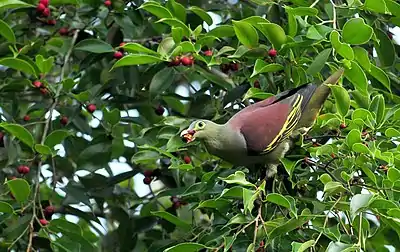| Thick-billed green pigeon | |
|---|---|
.jpg.webp) | |
| Scientific classification | |
| Domain: | Eukaryota |
| Kingdom: | Animalia |
| Phylum: | Chordata |
| Class: | Aves |
| Order: | Columbiformes |
| Family: | Columbidae |
| Genus: | Treron |
| Species: | T. curvirostra |
| Binomial name | |
| Treron curvirostra (Gmelin, JF, 1789) | |
The thick-billed green pigeon (Treron curvirostra) is a species of bird in the family Columbidae.
Taxonomy
The thick-billed green pigeon was formally described in 1789 by the German naturalist Johann Friedrich Gmelin in his revised and expanded edition of Carl Linnaeus's Systema Naturae. He placed it with all the other doves and pigeons in the genus Columba and coined the binomial name Columba curvirostra.[2] Gmelin based his description on the "Hook-billed Pigeon" from the "island of Tanna in the South Seas" that had been described and illustrated in 1783 by the English ornithologist John Latham.[3] Latham was mistaken in believing that his specimen had come from the island of Tanna in the New Hebrides. The type locality was designated as the Malay Peninsula by Harry C. Oberholser in 1912.[4][5][6] The thick-billed green pigeon is now placed with around 30 other green pigeons in the genus Treron that was introduced in 1816 by the French ornithologist Louis Pierre Vieillot.[7][8] The genus name is from the Ancient Greek trērōn meaning "pigeon" or "dove". The specific epithet curvirostra combines the Latin curvus meaning "curved" with -rostris meaning "billed".[9]
Nine subspecies are recognized:[8]
- T. c. nipalensis (Hodgson, 1836) – central Nepal and northeast India through Myanmar to south Indochina
- T. c. hainanus Hartert, EJO & Goodson, 1918 – island of Hainan (off southeast China)
- T. c. curvirostra (Gmelin, JF, 1789) – Malay Peninsula and Sumatra
- T. c. haliplous Oberholser, 1912 – Simeulue (west of north Sumatra)
- T. c. pegus Oberholser, 1912 – Nias (west of north Sumatra)
- T. c. smicrus Oberholser, 1912 – Sipura, Siberut and Batu Islands (west of central Sumatra)
- T. c. hypothapsinus Oberholser, 1912 – Enggano Island (west of south Sumatra)
- T. c. nasica Schlegel, 1863 – Borneo
- T. c. erimacrus Oberholser, 1924 – Mindoro and Palawan group (northwest, southwest Philippines)
Description
Rather small-sized pigeon being under 26 cm (10 in) as compared to other green pigeons. A thick pale greenish bill with red base, broad bluish-Green eye ring, grey crown and maroon mantle diagnostic. Wings have black primary and secondaries with yellow outer edge. Underside green in both sexes. Thighs dark green with whitish scales. Female has greenish undertail coverts with whitish scales. Males have maroon dorsum and dull chestnut undertail coverts.[10][11]
Distribution and habitat
It ranges across the eastern regions of the Indian Subcontinent and Southeast Asia, stretching from the Eastern Himalayas to Borneo and Sumatra.
Found across Bangladesh, Bhutan, Brunei, Cambodia, Hong Kong, India, Indonesia, Laos, Malaysia, Myanmar, Nepal, the Philippines, Singapore, Thailand, Tibet and Vietnam.
Its natural habitats are subtropical or tropical moist lowland forests and subtropical or tropical mangrove forests.[10][11]
Behaviour and ecology
Known to feed on syconia of Figs walking slowly along the branches.[11]

Various views and plumages
References
- ↑ BirdLife International (2018). "Treron curvirostra". IUCN Red List of Threatened Species. 2018: e.T22691160A130177198. doi:10.2305/IUCN.UK.2018-2.RLTS.T22691160A130177198.en. Retrieved 13 November 2021.
- ↑ Gmelin, Johann Friedrich (1789). Systema naturae per regna tria naturae : secundum classes, ordines, genera, species, cum characteribus, differentiis, synonymis, locis (in Latin). Vol. 1, Part 2 (13th ed.). Lipsiae [Leipzig]: Georg. Emanuel. Beer. p. 777.
- ↑ Latham, John (1783). A General Synopsis of Birds. Vol. 2, Part 2. London: Printed for Leigh and Sotheby. p. 632; Plate 59.
- ↑ Oberholser, Harry C. (1912). "Descriptions of one hundred and four new species and subspecies of birds from the Barussan Islands and Sumatra". Smithsonian Miscellaneous Collections. 60 (7): 1-22 [3, Note].
- ↑ Peters, James Lee, ed. (1937). Check-List of Birds of the World. Vol. 3. Cambridge, Massachusetts: Harvard University Press. p. 14.
- ↑ Gibbs, D.; Barnes, E.; Cox, J. (2001). Pigeons and Doves: A Guide to the Pigeons and Doves of the World. Robertsbridge, UK: Pica Press. pp. 435–436. ISBN 978-1-873403-60-0.
- ↑ Vieillot, Louis Pierre (1816). Analyse d'une Nouvelle Ornithologie Élémentaire (in French). Paris: Deterville/self. p. 49.
- 1 2 Gill, Frank; Donsker, David; Rasmussen, Pamela, eds. (January 2022). "Pigeons". IOC World Bird List Version 12.1. International Ornithologists' Union. Retrieved 18 August 2022.
- ↑ Jobling, James A. (2010). The Helm Dictionary of Scientific Bird Names. London: Christopher Helm. pp. 389, 125. ISBN 978-1-4081-2501-4.
- 1 2 Robson, Craig, and Richard Allen. New Holland field guide to the birds of South-East Asia. New Holland Publishers, 2005
- 1 2 3 "Pictures and description of the Pigon birds". Archived from the original on 2014-03-11. Retrieved 2014-03-11.

_at_Jayanti%252C_Duars%252C_West_Bengal_W_Picture_098.jpg.webp)
_at_Jayanti%252C_Duars%252C_West_Bengal_W_Picture_093.jpg.webp)